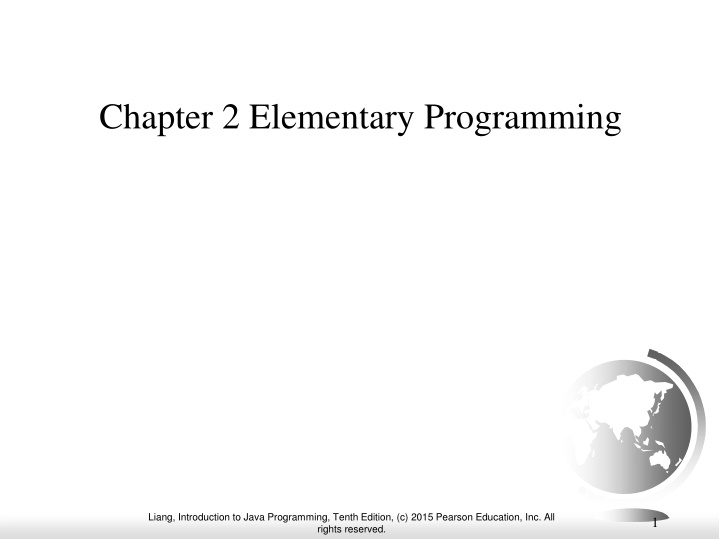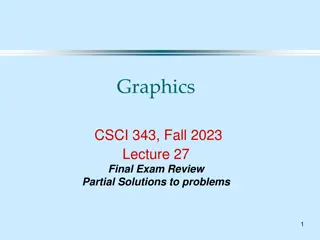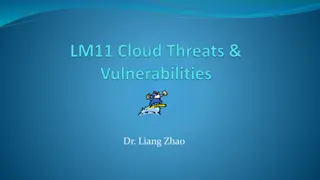
Learn Java Programming for Solving Practical Problems
Start learning Java programming with this guide that covers Java primitive data types, variables, constants, operators, expressions, input/output, and more. Explore numeric data types, perform computations, input/output operations, and avoid common errors. Get hands-on with examples like computing the area of a circle.
Download Presentation

Please find below an Image/Link to download the presentation.
The content on the website is provided AS IS for your information and personal use only. It may not be sold, licensed, or shared on other websites without obtaining consent from the author. If you encounter any issues during the download, it is possible that the publisher has removed the file from their server.
You are allowed to download the files provided on this website for personal or commercial use, subject to the condition that they are used lawfully. All files are the property of their respective owners.
The content on the website is provided AS IS for your information and personal use only. It may not be sold, licensed, or shared on other websites without obtaining consent from the author.
E N D
Presentation Transcript
Chapter 2 Elementary Programming Liang, Introduction to Java Programming, Tenth Edition, (c) 2015 Pearson Education, Inc. All rights reserved. 1
Motivations In the preceding chapter, you learned how to create, compile, and run a Java program. Starting from this chapter, you will learn how to solve practical problems programmatically. Through these problems, you will learn Java primitive data types and related subjects, such as variables, constants, data types, operators, expressions, and input and output. Liang, Introduction to Java Programming, Tenth Edition, (c) 2015 Pearson Education, Inc. All rights reserved. 2
Objectives To write Java programs to perform simple computations ( 2.2). To obtain input from the console using the Scanner class ( 2.3). To use identifiers to name variables, constants, methods, and classes ( 2.4). To use variables to store data ( 2.5 2.6). To program with assignment statements and assignment expressions ( 2.6). To use constants to store permanent data ( 2.7). To name classes, methods, variables, and constants by following their naming conventions ( 2.8). To explore Java numeric primitive data types: byte, short, int, long, float, and double ( 2.9.1). To read a byte, short, int, long, float, or double value from the keyboard ( 2.9.2). To perform operations using operators +, -, *, /, and % ( 2.9.3). To perform exponent operations using Math.pow(a, b) ( 2.9.4). To write integer literals, floating-point literals, and literals in scientific notation ( 2.10). To write and evaluate numeric expressions ( 2.11). To obtain the current system time using System.currentTimeMillis() ( 2.12). To use augmented assignment operators ( 2.13). To distinguish between postincrement and preincrement and between postdecrement and predecrement ( 2.14). To cast the value of one type to another type ( 2.15). To describe the software development process and apply it to develop the loan payment program ( 2.16). To write a program that converts a large amount of money into smaller units ( 2.17). To avoid common errors and pitfalls in elementary programming ( 2.18). Liang, Introduction to Java Programming, Tenth Edition, (c) 2015 Pearson Education, Inc. All rights reserved. 3
Introducing Programming with an Example Listing 2.1 Computing the Area of a Circle This program computes the area of the circle. Animation ComputeArea Animation Run Run Liang, Introduction to Java Programming, Tenth Edition, (c) 2015 Pearson Education, Inc. All rights reserved. 4
animation Trace a Program Execution allocate memory for radius public class ComputeArea { /** Main method */ public static void main(String[] args) { double radius; double area; // Assign a radius radius = 20; // Compute area area = radius * radius * 3.14159; // Display results System.out.println("The area for the circle of radius " + radius + " is " + area); } } no value radius Liang, Introduction to Java Programming, Tenth Edition, (c) 2015 Pearson Education, Inc. All rights reserved. 5
animation Trace a Program Execution public class ComputeArea { /** Main method */ public static void main(String[] args) { double radius; double area; // Assign a radius radius = 20; // Compute area area = radius * radius * 3.14159; // Display results System.out.println("The area for the circle of radius " + radius + " is " + area); } } memory radius no value area no value allocate memory for area Liang, Introduction to Java Programming, Tenth Edition, (c) 2015 Pearson Education, Inc. All rights reserved. 6
animation Trace a Program Execution assign 20 to radius public class ComputeArea { /** Main method */ public static void main(String[] args) { double radius; double area; // Assign a radius radius = 20; // Compute area area = radius * radius * 3.14159; // Display results System.out.println("The area for the circle of radius " + radius + " is " + area); } } radius 20 area no value Liang, Introduction to Java Programming, Tenth Edition, (c) 2015 Pearson Education, Inc. All rights reserved. 7
animation Trace a Program Execution public class ComputeArea { /** Main method */ public static void main(String[] args) { double radius; double area; // Assign a radius radius = 20; // Compute area area = radius * radius * 3.14159; // Display results System.out.println("The area for the circle of radius " + radius + " is " + area); } } memory 20 radius 1256.636 area compute area and assign it to variable area Liang, Introduction to Java Programming, Tenth Edition, (c) 2015 Pearson Education, Inc. All rights reserved. 8
animation Trace a Program Execution public class ComputeArea { /** Main method */ public static void main(String[] args) { double radius; double area; // Assign a radius radius = 20; // Compute area area = radius * radius * 3.14159; // Display results System.out.println("The area for the circle of radius " + radius + " is " + area); } } memory radius 20 area 1256.636 print a message to the console Liang, Introduction to Java Programming, Tenth Edition, (c) 2015 Pearson Education, Inc. All rights reserved. 9
Reading Input from the Console 1. Create a Scanner object Scanner input = new Scanner(System.in); 2. Use the method nextDouble() to obtain to a double value. For example, System.out.print("Enter a double value: "); Scanner input = new Scanner(System.in); double d = input.nextDouble(); Animation Animation ComputeAverage ComputeAreaWithConsoleInput Liang, Introduction to Java Programming, Tenth Edition, (c) 2015 Pearson Education, Inc. All rights reserved. 10
Identifiers An identifier is a sequence of characters that consist of letters, digits, underscores (_), and dollar signs ($). An identifier must start with a letter, an underscore (_), or a dollar sign ($). It cannot start with a digit. An identifier cannot be a reserved word. (See Appendix A, Java Keywords, for a list of reserved words). An identifier cannot be true, false, or null. An identifier can be of any length. Liang, Introduction to Java Programming, Tenth Edition, (c) 2015 Pearson Education, Inc. All rights reserved. 11
Variables // Compute the first area radius = 1.0; area = radius * radius * 3.14159; System.out.println("The area is + area + " for radius "+radius); // Compute the second area radius = 2.0; area = radius * radius * 3.14159; System.out.println("The area is + area + " for radius "+radius); Liang, Introduction to Java Programming, Tenth Edition, (c) 2015 Pearson Education, Inc. All rights reserved. 12
Declaring Variables int x; // Declare x to be an // integer variable; double radius; // Declare radius to // be a double variable; char a; // Declare a to be a // character variable; Liang, Introduction to Java Programming, Tenth Edition, (c) 2015 Pearson Education, Inc. All rights reserved. 13
Assignment Statements x = 1; // Assign 1 to x; radius = 1.0; // Assign 1.0 to radius; a = 'A'; // Assign 'A' to a; Liang, Introduction to Java Programming, Tenth Edition, (c) 2015 Pearson Education, Inc. All rights reserved. 14
Declaring and Initializing in One Step int x = 1; double d = 1.4; Liang, Introduction to Java Programming, Tenth Edition, (c) 2015 Pearson Education, Inc. All rights reserved. 15
Named Constants final datatype CONSTANTNAME = VALUE; final double PI = 3.14159; final int SIZE = 3; Liang, Introduction to Java Programming, Tenth Edition, (c) 2015 Pearson Education, Inc. All rights reserved. 16
Naming Conventions Choose meaningful and descriptive names. Variables and method names: Use lowercase. If the name consists of several words, concatenate all in one, use lowercase for the first word, and capitalize the first letter of each subsequent word in the name. For example, the variables radius and area, and the method computeArea. Liang, Introduction to Java Programming, Tenth Edition, (c) 2015 Pearson Education, Inc. All rights reserved. 17
Naming Conventions, cont. Class names: Capitalize the first letter of each word in the name. For example, the class name ComputeArea. Constants: Capitalize all letters in constants, and use underscores to connect words. For example, the constant PI and MAX_VALUE Liang, Introduction to Java Programming, Tenth Edition, (c) 2015 Pearson Education, Inc. All rights reserved. 18
Numerical Data Types Name Range Storage Size 27 to 27 1 (-128 to 127) byte short int long 8-bit signed 215 to 215 1 (-32768 to 32767) 16-bit signed 231 to 231 1 (-2147483648 to 2147483647) 32-bit signed 263 to 263 1 (i.e., -9223372036854775808 to 9223372036854775807) Negative range: -3.4028235E+38 to -1.4E-45 Positive range: 1.4E-45 to 3.4028235E+38 64-bit signed float 32-bit IEEE 754 double 4.9E-324 to 1.7976931348623157E+308 Negative range: -1.7976931348623157E+308 to -4.9E-324 64-bit IEEE 754 Positive range: Liang, Introduction to Java Programming, Tenth Edition, (c) 2015 Pearson Education, Inc. All rights reserved. 19
Reading Numbers from the Keyboard Scanner input = new Scanner(System.in); int value = input.nextInt(); Method Description nextByte() reads an integer of the byte type. nextShort() reads an integer of the short type. nextInt() reads an integer of the int type. nextLong() reads an integer of the long type. nextFloat() reads a number of the float type. nextDouble() reads a number of the double type. Liang, Introduction to Java Programming, Tenth Edition, (c) 2015 Pearson Education, Inc. All rights reserved. 20
Numeric Operators Name Meaning Example Result + Addition 34 + 1 35 - Subtraction 34.0 0.1 33.9 * Multiplication 300 * 30 9000 / Division 1.0 / 2.0 0.5 % Remainder 20 % 3 2 Liang, Introduction to Java Programming, Tenth Edition, (c) 2015 Pearson Education, Inc. All rights reserved. 21
Integer Division +, -, *, /, and % 5 / 2 yields an integer 2. 5.0 / 2 yields a double value 2.5 5 % 2 yields 1 (the remainder of the division) Liang, Introduction to Java Programming, Tenth Edition, (c) 2015 Pearson Education, Inc. All rights reserved. 22
Remainder Operator Remainder is very useful in programming. For example, an even number % 2 is always 0 and an odd number % 2 is always 1. So you can use this property to determine whether a number is even or odd. Suppose today is Saturday and you and your friends are going to meet in 10 days. What day is in 10 days? You can find that day is Tuesday using the following expression: Saturday is the 6th day in a week A week has 7 days (6 + 10) % 7 is 2 The 2nd day in a week is Tuesday After 10 days Liang, Introduction to Java Programming, Tenth Edition, (c) 2015 Pearson Education, Inc. All rights reserved. 23
Problem: Displaying Time Write a program that obtains minutes and remaining seconds from seconds. DisplayTime Liang, Introduction to Java Programming, Tenth Edition, (c) 2015 Pearson Education, Inc. All rights reserved. 24
NOTE Calculations involving floating-point numbers are approximated because these numbers are not stored with complete accuracy. For example, System.out.println(1.0 - 0.1 - 0.1 - 0.1 - 0.1 - 0.1); displays 0.5000000000000001, not 0.5, and System.out.println(1.0 - 0.9); displays 0.09999999999999998, not 0.1. Integers are stored precisely. Therefore, calculations with integers yield a precise integer result. Liang, Introduction to Java Programming, Tenth Edition, (c) 2015 Pearson Education, Inc. All rights reserved. 25
Exponent Operations System.out.println(Math.pow(2, 3)); // Displays 8.0 System.out.println(Math.pow(4, 0.5)); // Displays 2.0 System.out.println(Math.pow(2.5, 2)); // Displays 6.25 System.out.println(Math.pow(2.5, -2)); // Displays 0.16 Liang, Introduction to Java Programming, Tenth Edition, (c) 2015 Pearson Education, Inc. All rights reserved. 26
Number Literals A literal is a constant value that appears directly in the program. For example, 34, 1,000,000, and 5.0 are literals in the following statements: int i = 34; long x = 1000000; double d = 5.0; Liang, Introduction to Java Programming, Tenth Edition, (c) 2015 Pearson Education, Inc. All rights reserved. 27
Integer Literals An integer literal can be assigned to an integer variable as long as it can fit into the variable. A compilation error would occur if the literal were too large for the variable to hold. For example, the statement byte b = 1000 would cause a compilation error, because 1000 cannot be stored in a variable of the byte type. An integer literal is assumed to be of the int type, whose value is between -231 (2147483647). To denote an integer literal of the long type, append it with the letter L or l. L is preferred because l (lowercase L) can easily be confused with 1 (the digit one). (-2147483648) to 231 1 Liang, Introduction to Java Programming, Tenth Edition, (c) 2015 Pearson Education, Inc. All rights reserved. 28
Floating-Point Literals Floating-point literals are written with a decimal point. By default, a floating-point literal is treated as a double type value. For example, 5.0 is considered a double value, not a float value. You can make a number a float by appending the letter f or F, and make a number a double by appending the letter d or D. For example, you can use 100.2f or 100.2F for a float number, and 100.2d or 100.2D for a double number. Liang, Introduction to Java Programming, Tenth Edition, (c) 2015 Pearson Education, Inc. All rights reserved. 29
double vs. float The double type values are more accurate than the float type values. For example, System.out.println("1.0 / 3.0 is " + 1.0 / 3.0); displays 1.0 / 3.0 is 0.3333333333333333 16 digits System.out.println("1.0F / 3.0F is " + 1.0F / 3.0F); displays 1.0F / 3.0F is 0.33333334 7 digits Liang, Introduction to Java Programming, Tenth Edition, (c) 2015 Pearson Education, Inc. All rights reserved. 30
Scientific Notation Floating-point literals can also be specified in scientific notation, for example, 1.23456e+2, same as 1.23456e2, is equivalent to 123.456, and 1.23456e-2 is equivalent to 0.0123456. E (or e) represents an exponent and it can be either in lowercase or uppercase. Liang, Introduction to Java Programming, Tenth Edition, (c) 2015 Pearson Education, Inc. All rights reserved. 31
Arithmetic Expressions + + + + 3 4 10 ( 5 )( ) 4 x 9 x y a b c x + + ( 9 ) 5 x y is translated to (3+4*x)/5 10*(y-5)*(a+b+c)/x + 9*(4/x + (9+x)/y) Liang, Introduction to Java Programming, Tenth Edition, (c) 2015 Pearson Education, Inc. All rights reserved. 32
How to Evaluate an Expression Though Java has its own way to evaluate an expression behind the scene, the result of a Java expression and its corresponding arithmetic expression are the same. Therefore, you can safely apply the arithmetic rule for evaluating a Java expression. 3 + 4 * 4 + 5 * (4 + 3) - 1 3 + 4 * 4 + 5 * 7 1 3 + 16 + 5 * 7 1 3 + 16 + 35 1 19 + 35 1 54 - 1 53 (1) inside parentheses first (2) multiplication (3) multiplication (4) addition (5) addition (6) subtraction Liang, Introduction to Java Programming, Tenth Edition, (c) 2015 Pearson Education, Inc. All rights reserved. 33
Problem: Converting Temperatures Write a program that converts a Fahrenheit degree to Celsius using the formula: = (9 )( 32 ) celsius fahrenheit 5 Note: you have to write celsius = (5.0 / 9) * (fahrenheit 32) FahrenheitToCelsius Liang, Introduction to Java Programming, Tenth Edition, (c) 2015 Pearson Education, Inc. All rights reserved. 34
Problem: Displaying Current Time Write a program that displays current time in GMT in the format hour:minute:second such as 1:45:19. The currentTimeMillis method in the System class returns the current time in milliseconds since the midnight, January 1, 1970 GMT. (1970 was the year when the Unix operating system was formally introduced.) You can use this method to obtain the current time, and then compute the current second, minute, and hour as follows. ShowCurrentTime Elapsed time Time Current Time Unix Epoch 01-01-1970 00:00:00 GMT System.currentTimeMills() Liang, Introduction to Java Programming, Tenth Edition, (c) 2015 Pearson Education, Inc. All rights reserved. 35
Augmented Assignment Operators Liang, Introduction to Java Programming, Tenth Edition, (c) 2015 Pearson Education, Inc. All rights reserved. 36
Increment and Decrement Operators Liang, Introduction to Java Programming, Tenth Edition, (c) 2015 Pearson Education, Inc. All rights reserved. 37
Increment and Decrement Operators, cont. int i = 10; int newNum = 10 * i++; Same effect as int newNum = 10 * i; i = i + 1; int i = 10; int newNum = 10 * (++i); Same effect as i = i + 1; int newNum = 10 * i; Liang, Introduction to Java Programming, Tenth Edition, (c) 2015 Pearson Education, Inc. All rights reserved. 38
Increment and Decrement Operators, cont. Using increment and decrement operators makes expressions short, but it also makes them complex and difficult to read. Avoid using these operators in expressions that modify multiple variables, or the same variable for multiple times such as this: int k = ++i + i. Liang, Introduction to Java Programming, Tenth Edition, (c) 2015 Pearson Education, Inc. All rights reserved. 39
Assignment Expressions and Assignment Statements Prior to Java 2, all the expressions can be used as statements. Since Java 2, only the following types of expressions can be statements: variable op= expression; // Where op is +, -, *, /, or % ++variable; variable++; --variable; variable--; Liang, Introduction to Java Programming, Tenth Edition, (c) 2015 Pearson Education, Inc. All rights reserved. 40
Numeric Type Conversion Consider the following statements: byte i = 100; long k = i * 3 + 4; double d = i * 3.1 + k / 2; Liang, Introduction to Java Programming, Tenth Edition, (c) 2015 Pearson Education, Inc. All rights reserved. 41
Conversion Rules When performing a binary operation involving two operands of different types, Java automatically converts the operand based on the following rules: 1. If one of the operands is double, the other is converted into double. 2. Otherwise, if one of the operands is float, the other is converted into float. 3. Otherwise, if one of the operands is long, the other is converted into long. 4. Otherwise, both operands are converted into int. Liang, Introduction to Java Programming, Tenth Edition, (c) 2015 Pearson Education, Inc. All rights reserved. 42
Type Casting Implicit casting double d = 3; (type widening) Explicit casting int i = (int)3.0; (type narrowing) int i = (int)3.9; (Fraction part is truncated) What is wrong? int x = 5 / 2.0; range increases byte, short, int, long, float, double Liang, Introduction to Java Programming, Tenth Edition, (c) 2015 Pearson Education, Inc. All rights reserved. 43
Problem: Keeping Two Digits After Decimal Points Write a program that displays the sales tax with two digits after the decimal point. SalesTax Liang, Introduction to Java Programming, Tenth Edition, (c) 2015 Pearson Education, Inc. All rights reserved. 44
Casting in an Augmented Expression In Java, an augmented expression of the form x1 op= x2 is implemented as x1 = (T)(x1 op x2), where T is the type for x1. Therefore, the following code is correct. int sum = 0; sum += 4.5; // sum becomes 4 after this statement sum += 4.5 is equivalent to sum = (int)(sum + 4.5). Liang, Introduction to Java Programming, Tenth Edition, (c) 2015 Pearson Education, Inc. All rights reserved. 45
Software Development Process Liang, Introduction to Java Programming, Tenth Edition, (c) 2015 Pearson Education, Inc. All rights reserved. 46
Requirement Specification A formal process that seeks to understand the problem and document in detail what the software system needs to do. This phase involves close interaction between users and designers. Requirement Specification System Analysis System Design Implementation Testing Most of the examples in this book are simple, and their requirements are clearly stated. In the real world, however, problems are not well defined. You need to study a problem carefully to identify its requirements. Deployment Maintenance Liang, Introduction to Java Programming, Tenth Edition, (c) 2015 Pearson Education, Inc. All rights reserved. 47
System Analysis Requirement Specification Seeks to analyze the business process in terms of data flow, and to identify the system s input and output. System Analysis System Design Implementation Part of the analysis entails modeling the system s behavior. The model is intended to capture the essential elements of the system and to define services to the system. Testing Deployment Maintenance Liang, Introduction to Java Programming, Tenth Edition, (c) 2015 Pearson Education, Inc. All rights reserved. 48
System Design The process of designing the system s components. Requirement Specification System Analysis System Design Implementation Testing This phase involves the use of many levels of abstraction to decompose the problem into manageable components, identify classes and interfaces, and establish relationships among the classes and interfaces. Deployment Maintenance Liang, Introduction to Java Programming, Tenth Edition, (c) 2015 Pearson Education, Inc. All rights reserved. 49
IPO Requirement Specification System Analysis Input, Process, Output System Design Implementation Testing The essence of system analysis and design is input, process, and output. This is called IPO. Deployment Maintenance Liang, Introduction to Java Programming, Tenth Edition, (c) 2015 Pearson Education, Inc. All rights reserved. 50






